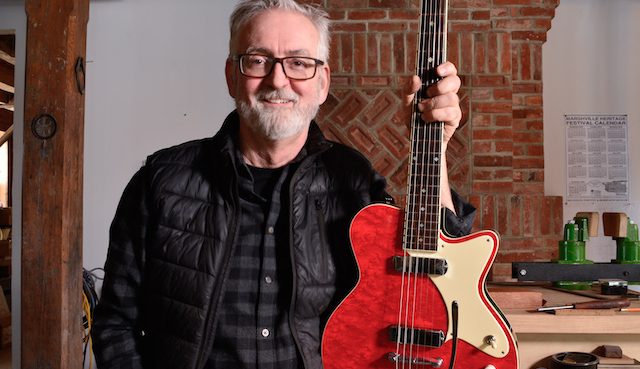
A native of Toronto, Joseph Yanuziello is the master craftsman behind some of the world’s most sought-after guitars.
In the boutique guitar marketplace, where instruments routinely command $5,000 or more, Joseph Yanuziello’s instruments have become so popular you might think his company’s motto is “sold out.” As fast as he can build his stunning instruments — which draw universal raves for their sound, look and feel — they’re gone.
Working from a shop outside his native Toronto, Yanuziello builds stringed instruments that reflect a singular vision. While so many companies outsource parts from overseas, he builds his own. While many copy the styles of Fender, Gibson and Martin, Yanuziello creates models themselves worthy of imitation.
Yanuziello learned his fearless, creative approach to hand-built creations from his father, who worked in sheet metal and carpentry. Here he shares with Lou&A the background behind his successful career and how rich roots fed his formative years.
Lou&A: Tell us about your family background.
Joseph Yanuziello: My Italian grandfather, Giuseppe Iannuzziello, emigrated to Toronto around 1900. His hometown was Pisticci in the province of Matera in the region of Basilicata. My father’s parents were both Italian. My grandmother, who he met in Toronto, was Mildred Abate. When my grandfather arrived in Canada, his last name was changed to the spelling of Yanuziello, perhaps during the process of emigration.
My grandparents raised five children, and my father, Joseph, was the youngest. My mother came from an Irish/Welsh background, and apparently an Italian and Irish combination was not uncommon back then.
Lou&A: What was it like growing up in an Italian household, and how did it influence your path to first-rate luthier?
Yanuziello: My Italian grandfather died when I was 2; this was in 1954. The subway had just opened in Toronto and my grandfather took a fall on his way down the stairs to the subway.
As a young boy, in the mid-to-late ’50s, I remember going to my grandmother’s house every Sunday in Little Italy where the whole family would convene for dinner. My family lived two doors away, so every weekend I would get to see my cousins, aunts and uncles. The essence of my grandfather was especially present in the basement, where all his tools and winemaking apparatus resided. In retrospect, my grandmother most likely left it as a shrine in honor of his memory.
Meanwhile, my father had a sheet metal shop up the street. I would hang out there sometimes while he worked. He also did some carpentry, and I remember being fascinated by all of this. There was a certain comfort I felt in his ability to do things and make things.
Lou&A: What inspired your desire to build guitars?
Yanuziello: The idea came to me after finishing art college, and I had become a full-time cabinetmaker. At that point, I had enough skill to try to build an acoustic guitar.
Without realizing it, I had learned how to work with confidence from watching my father and working with him. Mostly from him, I acquired a good work ethic and the idea that there was nothing to fear in trying things out.
Lou&A: How would you describe your building approach and philosophy?
Yanuziello: I would say that I’m trying to build instruments that are uniquely mine, that are built with integrity and style, and ultimately function as reliable tools for creative musicians to inspire their art form.
I’m also self-taught. When I built my first guitar in 1979, there were no schools for guitar building in Ontario or most other places. And before the Internet, there was very little information on the subject. So whatever I could find in books or articles, I read — more like devoured. This idea of building a guitar was, at the time, just a notion or a potential hobby, and secondary to my career as a furniture designer and cabinetmaker.
Once I had built a number of guitars over the next few years, acoustic and electric, I started to realize that this could be a vocation instead of cabinetmaking. Fortunately, the same tools and skill set are required for both, so the transition wasn’t that difficult.
Lou&A: With all the competition out there, what do you think contributes to your success?
Yanuziello: Competition is a good thing. It raises the bar and raises people’s awareness of the possibilities. In my case, the unique design of my electric instruments has finally been recognized as a brand after many years of being in the marketplace. I think that there’s a lot to be said for being persistent, having faith in what you do, and that working very hard will produce results. As they say, the harder you work, the luckier you get.
Lou&A: I understand some Italian guitar models influenced your building. Tell us about that.
Yanuziello: Yes, definitely. In Italy in the 1960s, many factories, large and small, produced accordions and stringed instruments. The accordions and drums were often covered in pearl, or glitter acetate and celluloid, and manufacturers such as Eko, Galanti, Gemelli and Wandre were quick to pick up on the visual appeal. It was the equivalent to what U.S. automobile manufacturers were doing at that time with fins and chrome.
Lou&A: Then came your own twist.
Yanuziello: A couple of years ago, I decided to pay tribute to these Italian electric guitars by designing and producing my own version. I started off with a prototype, which was called the Stella Bella Strada. It was built at the request of my friend and incredible guitar player Kevin Breit. Kevin wanted me to make this thing stand out, so I came up with the idea of creating an homage to the wild Italian electric guitars of the ’60s.
The pickup grills were see-through so that allowed us to put a period photo of Sophia Loren looking through the grill in one pickup cover and a picture of Marcello Mastroianni in the other. I had two button switches light up that control the pickup functions, and the lever that selects the pickups had a tip that resembled a vintage Gaggia espresso machine lever.
This guitar worked out so well that I decided to do a series of 10. I call the series the Milano, and all 10 share the same specs, except the top color on each one is a different sparkle. The back, sides and neck are lacquered in a cream color that I call Mascarpone. The result is striking, and the Milano series could easily fit into the ’60s vibe. I’m pleased to say that I’ve sold six out of 10 of my first special-edition series.
Lou&A: When you think about your Italian heritage today, how do you feel it has most informed your work?
Yanuziello: I’ve always been and continue to be proud of my Italian heritage. When you look at history, recent and past, so many great original ideas have been realized by Italian artists, crafters and designers. Art, architecture, furniture, food, fashion, automobile design, science, manufacturing — the list goes on — have all been greatly influenced by Italians over the last century and beyond. It’s exciting to be part of that tradition, and hopefully I’ll leave something behind that holds up to it.
To learn more, click here.
The above appears in the April 2020 issue of the print version of Fra Noi. Our gorgeous, monthly magazine contains a veritable feast of news and views, profiles and features, entertainment and culture. To subscribe, click here.
 Fra Noi Embrace Your Inner Italian
Fra Noi Embrace Your Inner Italian






